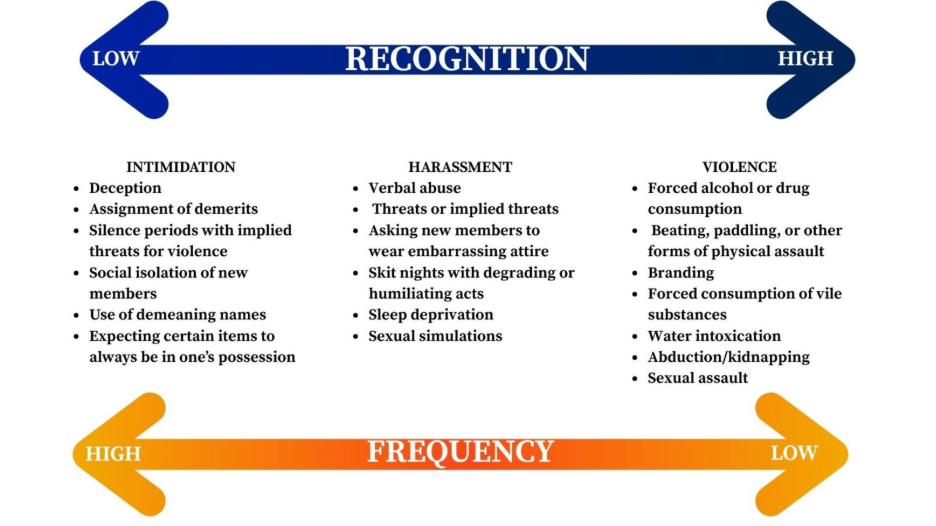What is Hazing?
According to a 2008 study conducted by Dr. Elizabeth Allan:
95%
95% of students who experience hazing do not report it
74%
74% of students involved in varsity athletics programs experienced behaviors meeting the definition of hazing in order to join or maintain membership on their team
73%
73% of students involved in social fraternities or sororities experienced behaviors meeting the definition of hazing in order to join or maintain membership in their group
71%
71% of students who witness hazing indicated that alcohol was involved in some way
55%
55% of students who participate in groups experience hazing
47%
47% of students come to college having already experienced hazing
Definition of Hazing at UF
3 main components:
- Occurs in a group
- Includes humiliating, degrading, and endangering behaviors
- Happens regardless of an individual's willingness to participate
Hazing (as defined by UF Regulation 4.040) means any action or series of actions that recklessly or intentionally endangers the mental health, physical health or safety of a Student for any purpose, including but not limited to initiation into, admission into, affiliation with, or the perpetuation or furtherance of a tradition or ritual of any Student group or Organization. Hazing occurs if a person or group:
- Causes or attempts to cause physical injury or other harm to a Student, including but not limited to emotional distress, or engages in any conduct that presents a threat to the Student’s health or safety. Hazing includes but is not limited to any physical brutality, such as whipping; beating; branding; exposure to the elements; forced consumption of any food, alcohol, drug or other substance; or other forced physical activity that could adversely affect the physical health, mental health or safety of any Student and any activity that would subject the Student to extreme mental stress, such as sleep deprivation, forced sexual conduct or forced exclusion from social contact.
- Engages in an action or activity that has a tendency to or is intended to demean, disgrace, humiliate or degrade a Student. This includes, but is not limited to, forced conduct that could result in extreme embarrassment, requiring servitude, or other forced activity that is considered Hazing under Florida law and could adversely affect the mental health or dignity of the Student.
- Conduct that by design, intent or recklessness causes a Student to be reasonably unable to pursue, interferes with, or attempts to interfere with a Student’s academic schedule or performance; or Causes, induces, pressures, coerces or requires a Student to violate the law or any UF Regulation.
In response to allegations of Hazing under this Regulation, it is not a defense that:
- The affected person gave consent.
- The conduct was not part of an official organizational event or sanctioned or approved by the organization.
- The conduct was not done as a condition of membership in the organization.
Student Organization
Student Organization (as defined under UF Regulation 4.040) means an association or group of persons that has complied with the formal requirements for recognition or is in the formal process of obtaining recognition. Under UF Regulation 4.040, the term “Student” is interchangeable with “Student Organization” when the term “Student Organization” is not directly specified.
University Community
University Community (as defined under UF Regulation 4.040) means University Officials, faculty, other employees, Students, and other people or entities who participate in any UF activity or program.
University Official
University Official (as defined under UF Regulation 4.040) means any person UF employs, contracts, or appoints to perform assigned teaching, research, administrative, professional, or other responsibilities.
Retaliation
Retaliation means no person may intimidate, threaten, coerce, or discriminate against any individual for good faith reporting of Hazing allegations. Retaliation includes threats, intimidation, harassment, coercion, violence, or any other conduct that would discourage a reasonable person from engaging in activity protected under this Policy.
Activity protected under this Policy may include an individual’s right to make a report and/or file a complaint, an individual’s ability to participate in the investigation process, and/or an individual’s good faith effort to intervene as a bystander.
Spectrum of Hazing

Long Description
Citation: (ALLAN, 2005; ALLAN AND KERSCHNER 2020; ADAPTED FROM BRINGING IN THE BYSTANDER)
Intimidation behaviors occur with high frequency, but are typically not classified by students as hazing since they are overlooked or justified as traditions, pranks, and jokes.
Warning Signs
- Changes in behavior and communication that may correspond with timing of person becoming involved in an organization
- Disrupted routine
- Falling behind in classes
- Bruises
- Downplays activities they must complete as traditions
- Chronic fatigue
- Symptoms of depression
- Social insolation
- Social media
- Decrease in use, turning off location
- Secrecy about activities
Hazing Resources:
Hazing Prevention Network Hazing Facts
Stop Hazing's Hazing Statistics
University of Maine's Hazing Prevention Research
Possible Warning Signs of Hazing (PDF 191 KB)
Detecting Signs of Hazing in Fraternities and Sororities (PDF 499 KB)
Bystander Intervention Guide (PDF 4729 KB)
